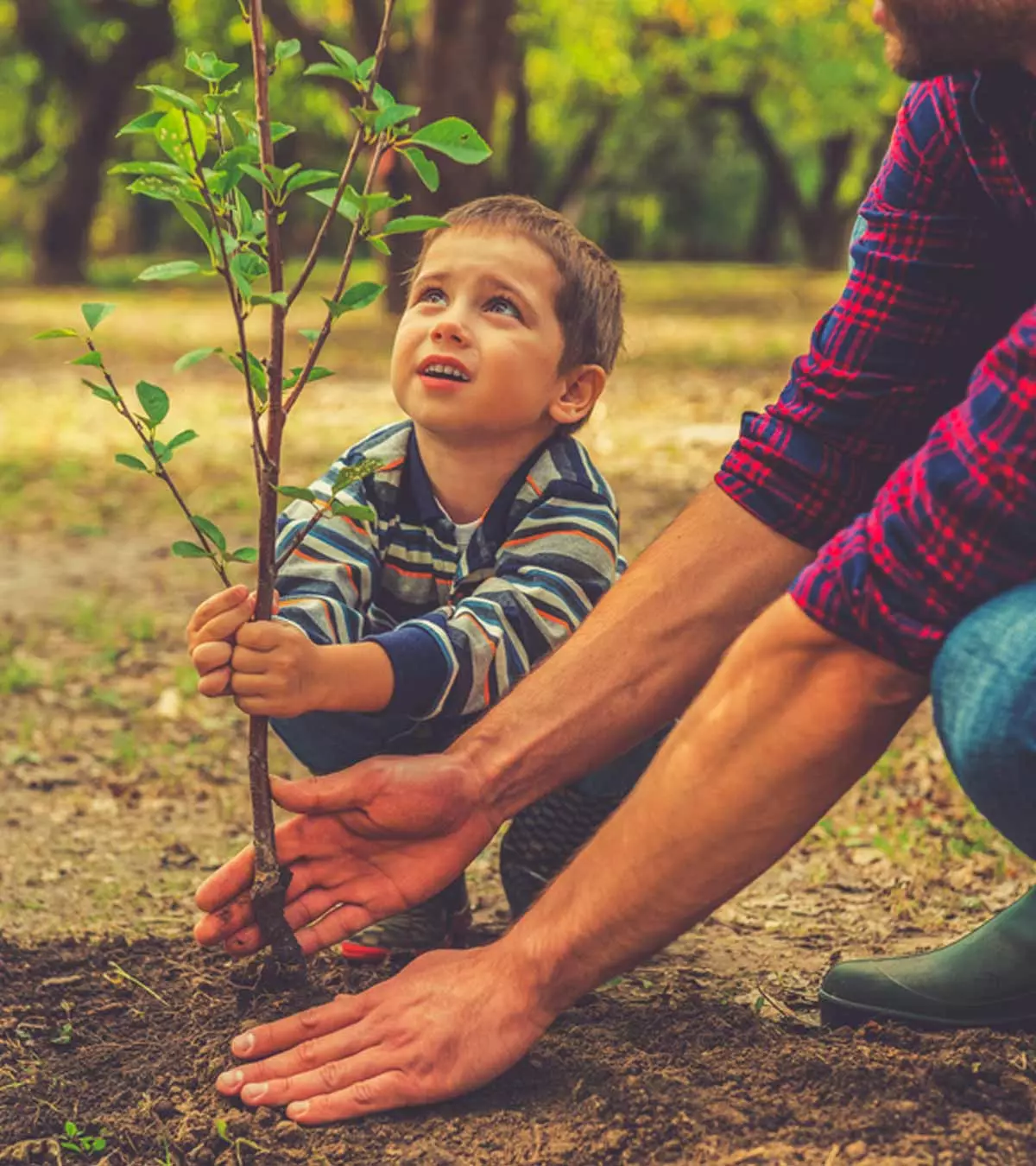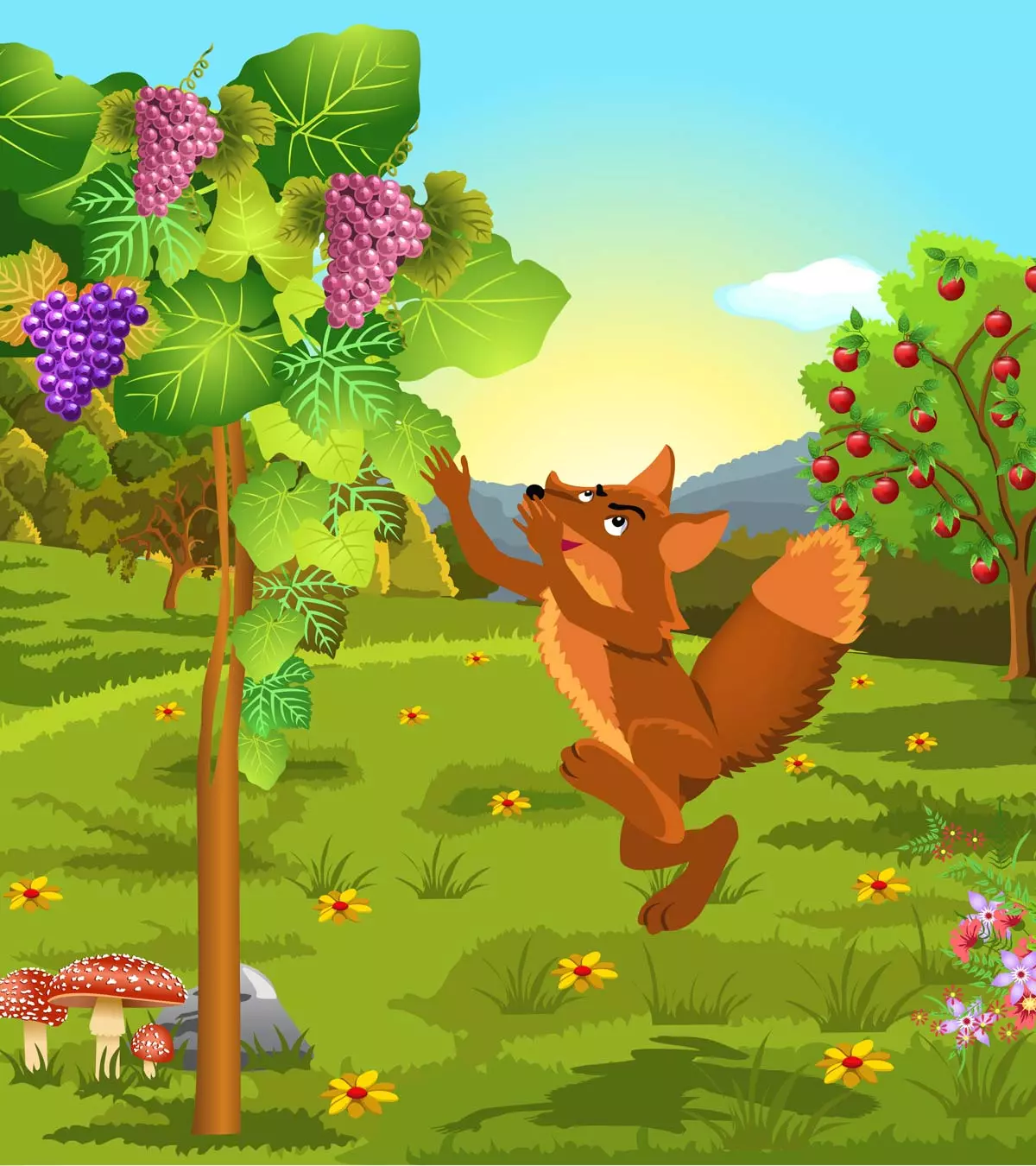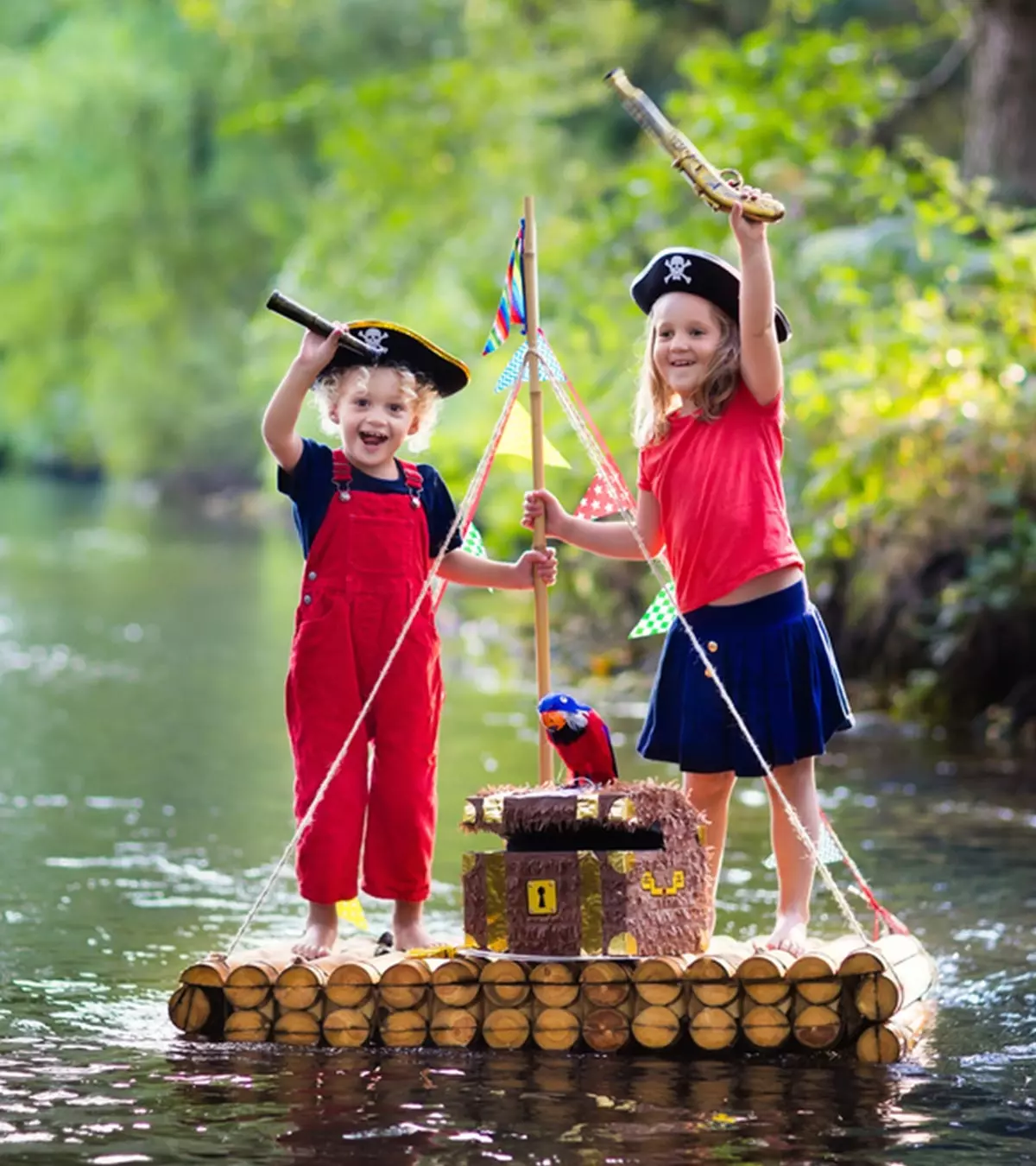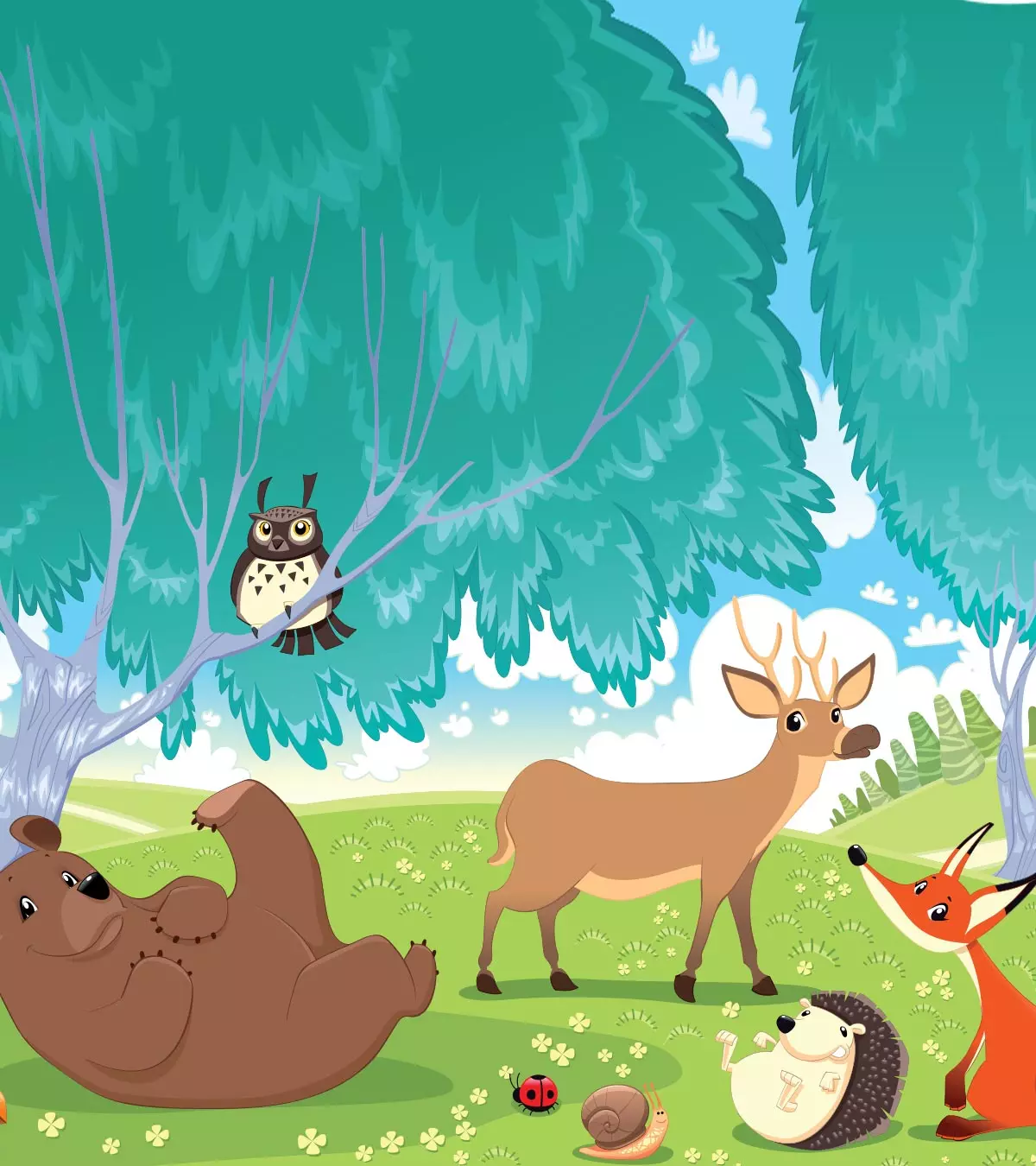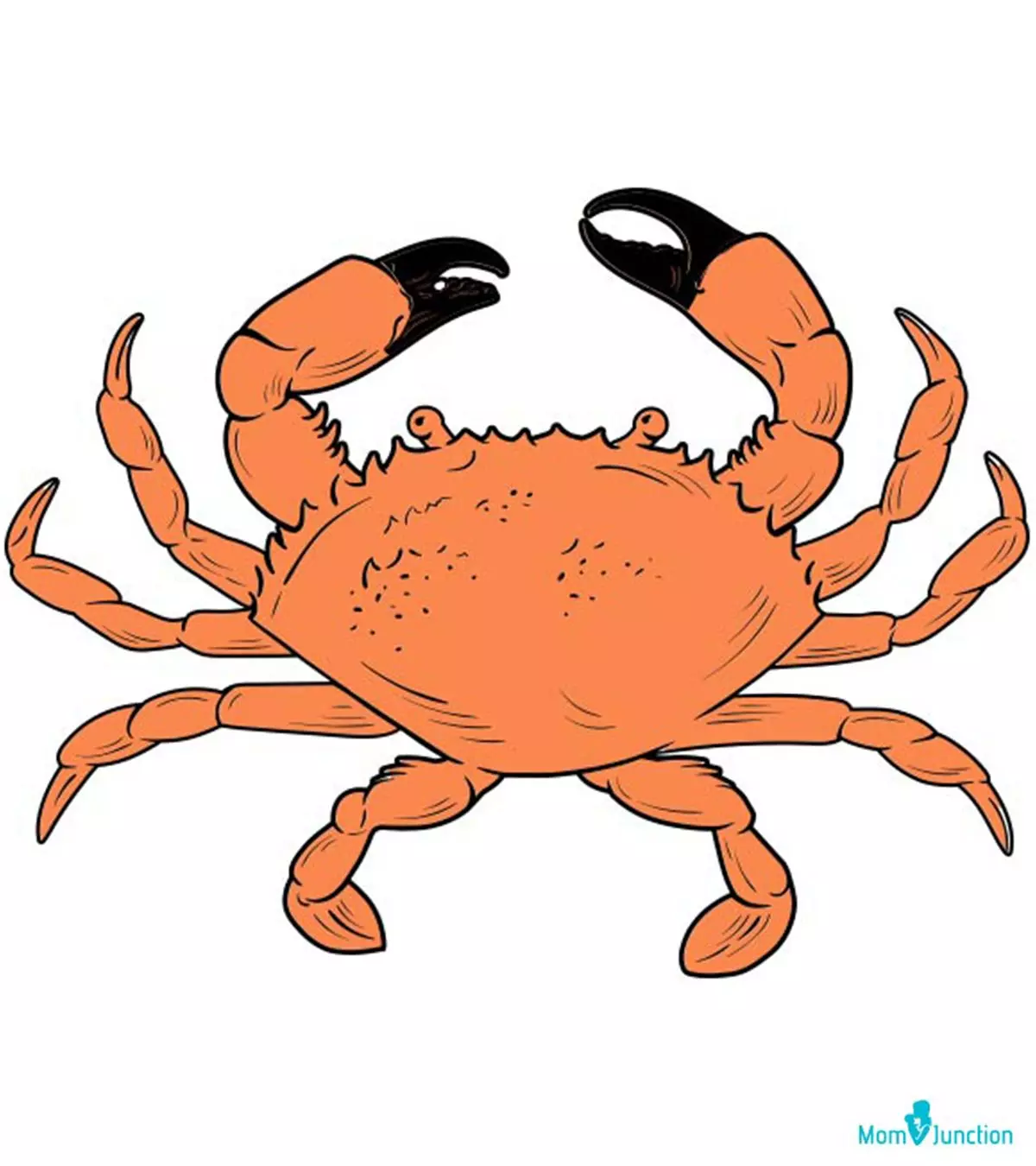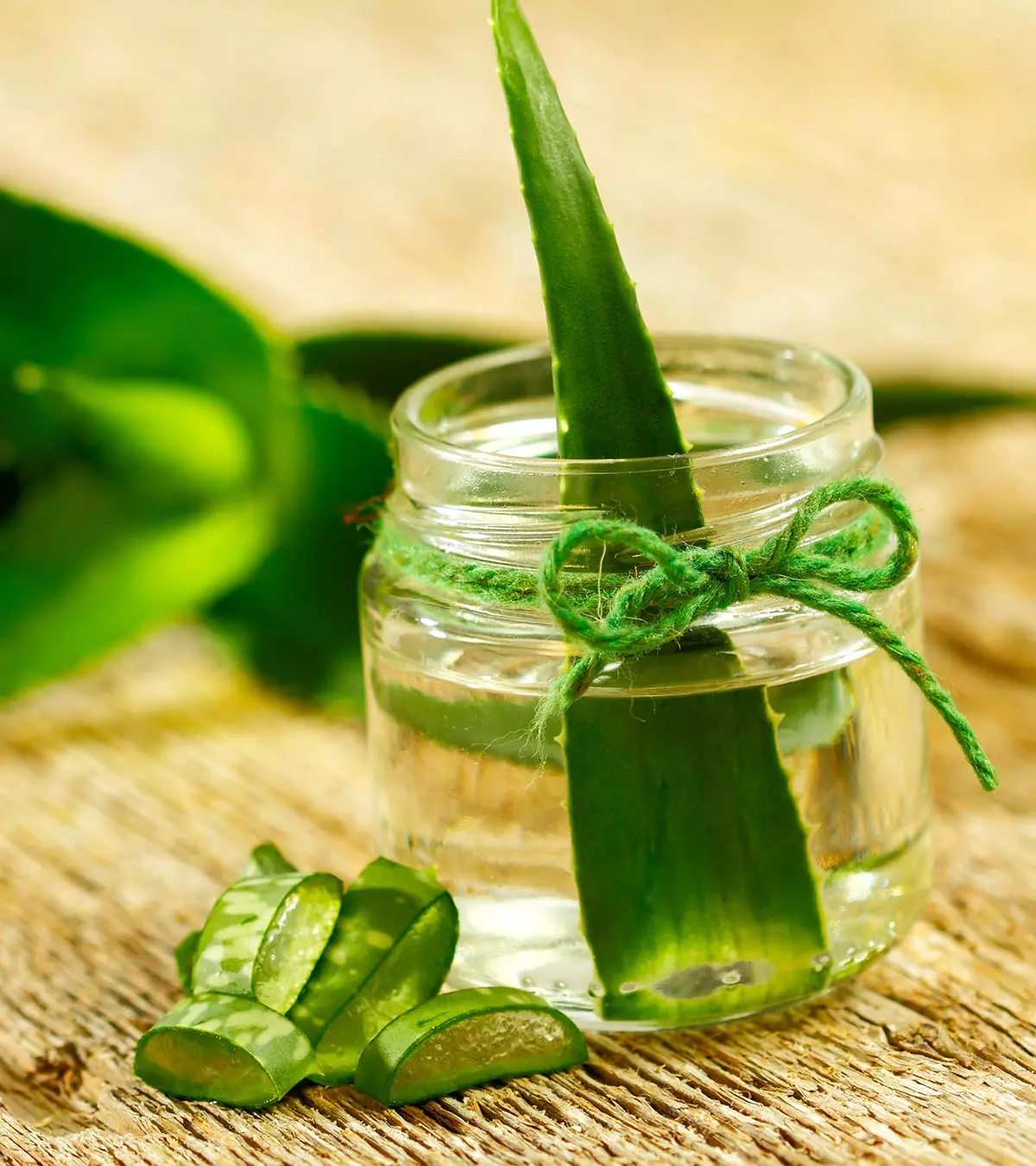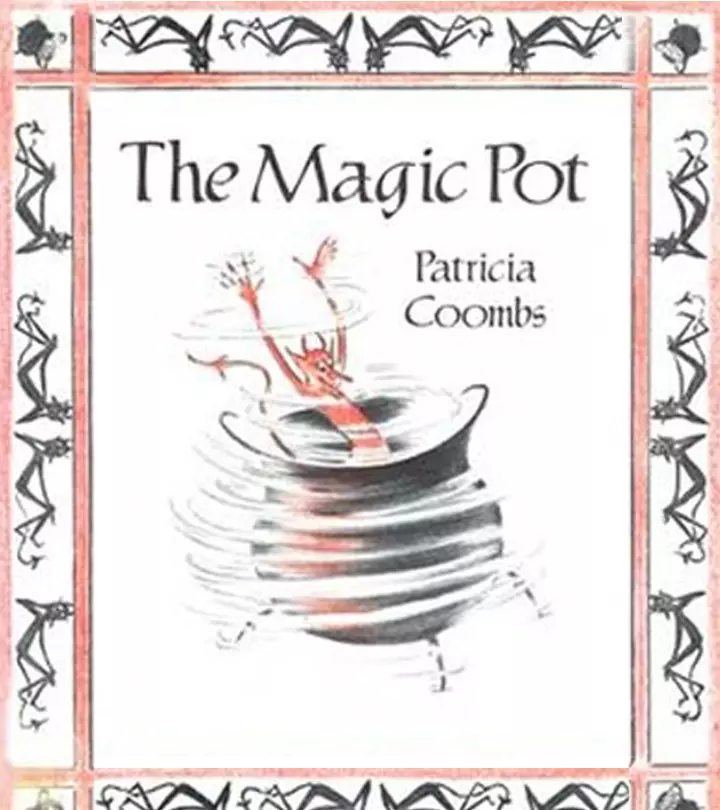
Image: iStock
Maintaining the greenery of the planet and reducing carbon footprint is our responsibility.

CompostingiA process of recycling organic materials into nutrient-rich soil through natural decomposition. for kids and learning more about the environment from a young age can make them responsible citizens.
Composting can be a fun, productive family activity if everyone gets involved. They may be taught about lesser waste production, avoiding plastic usage that typically goes to the landfills and harms the environment further. Read on to know the importance of teaching composting to kids and the right way to do it.
Key Pointers
- Composting with your kids helps you teach them about the importance of giving back and taking care of the environment.
- You can educate your children on how to compost by locating the best composting location and separating compostable and non-compostable materials.
- Teaching them about the three R’s, giving them a quick science lesson, and various other activities listed in this post.
6 Benefits Of Teaching Composting To Kids
Composting is a great way to keep your little garden flourishing while you do your bit towards a greener earth.
And doing it with your family makes the task more efficient and ensures your little ones learn to take responsibility. Here are a few benefits of teaching composting to your children.
1. Makes for a constructive family activity
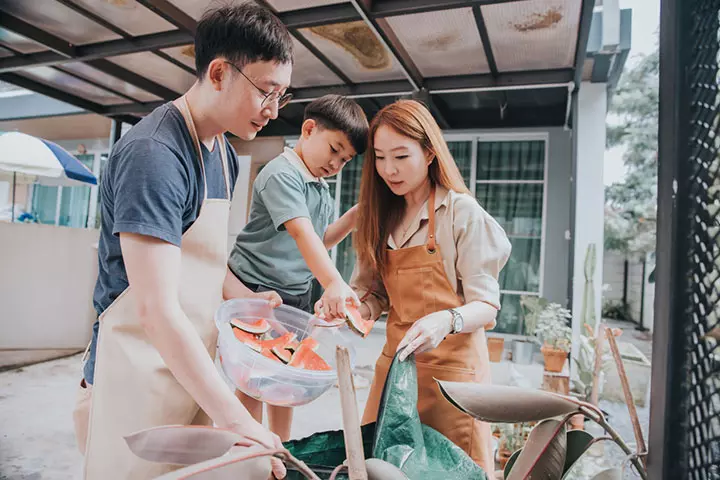
You must be looking for a fun activity for children that doesn’t involve watching the screen or staying indoors curled up on the couch. Composting fits the bill perfectly. It is a family activity that involves zero cost, gives valuable education to children, and you don’t have to leave your home.
Even young children can be introduced to the basics. Give them a plastic pop bottle as a mini compost bin and involve them in something constructive and educational.
Zigler Ridge, a mother and a youtuber, jokingly shares how teaching her children the importance of composting has been productive for her child and her. She says, “I am not gonna turn down the help when it presents itself… It’s a great way to get your kids involved in composting slash less work for you (i).”
2. Teaches them about self-sufficiency and optimal utilization
Teach your children about optimal utilization by explaining to them that the food waste from your home that usually goes into stinky trash bags can instead help your garden bloom. You can also teach them about self-sufficiency by pointing out that you don’t need to buy fertilizer from outside to make the plants grow healthy. Composting demonstrates how you can be self-sufficient and put something that usually ends up in the trash receptacle to good use.
3. Fosters a love of nature and environmental responsibility
When you inculcate a love of nature and the Earth in children at an early age, they grow up to become environmentally conscious and socially responsible adults.
Involving them in garden activities for kids such as composting can help you introduce them to the wonders of nature and teach them to respect and protect it.
Composting can be a great opportunity to teach kids how dumping massive amounts of waste in landfills harms the planet inadvertently. You can teach them how nature’s balance is affected and why even small steps, such as composting, can help in a big way.
 Point to consider
Point to consider4. Teaches the three Rs
Teaching reduce, reuse, and recycle to kids lets you promote the right values in them early in life. Composting teaches them how to reduce their household organic waste, recycle it, and channel it into productive use. It encourages them to come up with ideas to reuse inorganic waste. For instance, they can use plastic bins for composting instead of throwing them away and filling landfills.
5. Reduces food waste
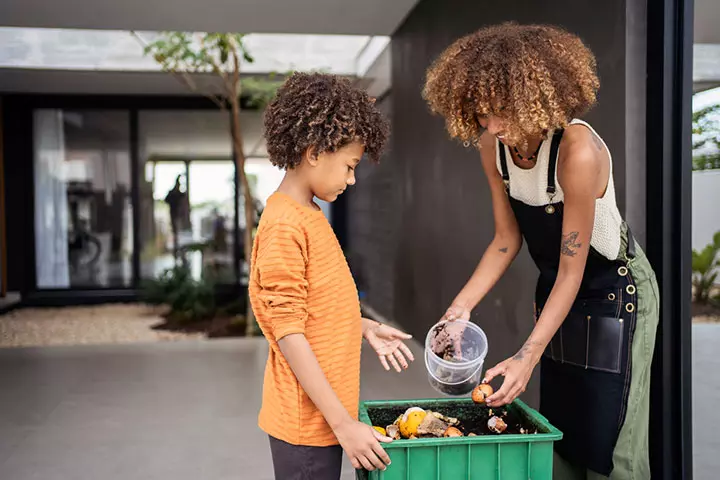
Show your children how vegetable scraps, fruit scraps, and food waste need not be thrown away but can be used to produce nutrient-rich soil. By teaching them to utilize food waste as compost material, you are teaching them how to reduce the total food waste now and in the future.
6. Gives a quick science lesson
Teaching children about the composting cycle can be a fun science lesson on ecosystemsiA community of living and nonliving things that interact with each other in a specific environment. too. Your child learns how the smallest insects and worms can impact and add value to critical processes. It can be a great opportunity to learn how different types of waste break down, how organic matter is different from inorganiciMaterials or substances that do not come from living organisms and do not contain carbon-hydrogen bonds. matter, and much more.
And above all, composting gives them the satisfaction of doing their bit for the planet.
How To Teach Kids To Make Compost?
As soon as your child begins to show curiosity in things you do, you can explain what you are doing and why. Start by telling them that you are making extra food for the plants to grow healthy and big.
1. Explain different types of waste
Teach them the difference between compostable and non-compostable waste. Show how organic food waste and other types of waste, such as newspapers, decompose quickly and can be used in your compost bin. In contrast, other types, such as plastics, should be avoided because they are not biodegradableiMaterials that can be naturally decomposed and returned to the environment through the action of microorganisms and other natural processes. .
 Quick tip
Quick tip2. List out compostable and non-compostable materials
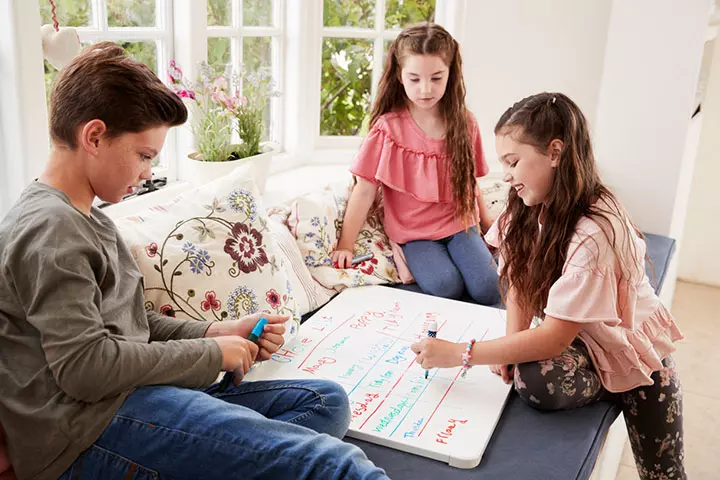
All kitchen waste cannot be used in your compost bucket. With your child’s help, list the things that can be added to the compost (fruit, veggies, grass, eggshells, leaves, newspaper, coffee, tea grinds, brown material from the garden) and those that cannot (meat, bones, shells, dairy products, oils, and fats). It helps them segregate kitchen waste properly.
3. Get the compost bin ready
If you have a garden or backyard, you can set up a full-sized compost bin. Buy one or prepare one at home. If you have a kitchen garden or want to start small, even a plastic pop bottle would do.
- Keep the lid of the pop bottle
- Cut around the bottom or base about 2/3rd of the way.
- Turn the bottle upside down and flip it open using the cut-out part.
- Drill holes in the bottle base to let air in.
- Make some holes at the sides for excess moisture to drain out.
Your micro compost bin is ready. If you are making a large garden compost bin, follow the same steps except for the compost container’s inversion.
4. Find the right spot
The compost bin has to be in the right spot so that the contents decompose quickly. Involve your child in identifying a location where the bin and its contents will be exposed to the sun, enough to maintain warmth inside and break down the waste.
5. Prepare the spot
Ensure the ground is even and the compost bin (if it is outdoors) is on bare soil. It allows worms and insects to get in and help with the decompositioniThe process by which dead plants and animals are broken down and recycled by microorganisms, returning nutrients to the ecosystem. process. Make sure the composting container is not in a dip on the land. The water inside must drain out quickly and easily and should not stagnate inside. For a micro compost bin, check its position so that water does not accumulate inside.
6. Start filling the micro compost bin
Ask your child to follow these steps to fill an indoor micro bin.
- Put in a handful of soil at the bottom.
- Moisten the soil with water from a spray bottle or sprinkle a few water droplets to dampen it.
- Add some mulch material like organic waste and fruit or vegetable scraps.
- Add another thin layer of soil.
- If you have yard waste, such as dry leaves, you can add some.
- Add a layer of soil at the top and moisten it by spraying some water.
- Cover the bin.
7. Water periodically

Ask the child to check the compost and spray water as soon as they see the topsoil drying out. They can see the crumbly nutrient-rich soil that the composting has created in about eight weeks.
8. Layer the bottom of the garden compost bin
If you introduce your child to a full-sized garden compost bin, teach them the following points.
- The bottom layer should be made of four to six inches of brown material—dead plants and twigs. It lets the water flow out quickly and ensures air circulation inside.
- Over this, you can ask the child to add dry leaves, soil layers, and organic waste layers.
- If you already have a full-sized composting bin in your backyard or garden, your child can be actively involved in filling it up with the right things, maintaining it, and then distributing the compost among the various plants.
9. Monitor the composting process
Ask your child to monitor the compost in the micro bin and regularly mix the contents while ensuring there is no excess water.
With a garden compost bin, your child can add new organic waste periodically and check if the bottom layers are ready for use.
 Do remember
Do remember10. Add compost to the daily routine
After every meal or snack, ask the child to take the organic waste to the compost bin. Make this a part of the routine, and you can show how quickly you can generate a good amount of nutrient-rich soil for the garden. Place a container on your kitchen counter to add the compostable kitchen waste daily, and ask the child to empty it in the main compost container every evening.
11. Schedule the weekend for maintenance
Turning the soil over with a garden fork or compost aerator and checking if it has enough moisture can be done periodically. If you have a garden or backyard, it could be another family activity you can do outdoors. With a plastic pop bottle, the child can roll the bottle around to let air circulate inside. For a bigger container, such as a tub or box, give your child a small shovel or stick to turn the contents over.
12. Make your worm compost
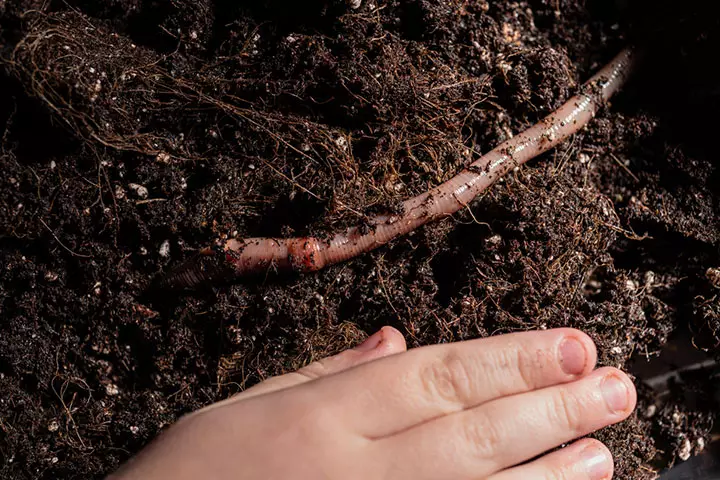
Worm composting bins teach children how little creatures play a role in maintaining balance in the natural surroundings by turning food scraps into rich vermicompost (1). You can buy a vermicompost bin online or make one on your own. The red worms, Eisenia foetida or Lumbricus rubellus, that eat the food scraps and make compost are easily available. Check with other worm bin owners to know where to purchase them. Harvesting the compost from the worm bin by separating worms from ready compost is another activity that children may like to help you with.
13. Harvest the compost and distribute
When the contents of your compost bin turn crumbly and dark, the compost is ready for use. With a micro bin made with a plastic pop bottle or something similar, the child can check if the compost is ready by simply turning the container over. But with a large garden bin, you might have to help the child identify if the compost is ready for use using a spade or shovel.
What Not To Put In The Compost Bin
Certain things that should not go into the compost bin. These include:
- Fish, meat, bones, dairy products, oily foods, and baked items are difficult to decompose and emit foul smells that attract insects and rodents.
- Cooked grains as they may support the growth of bad bacteria.
- Diseased plants, weeds or pesticide-treated plants, and wood scrapings. They may make the compost toxic.
- Stickers on fruits or vegetables and plastic-coated (glossy) paper as they are not biodegradable.
- Citrus fruit peels because they alter the compost pH (they are acidic), which may slow down the composting process.
- Onion and garlic peels in vermicompost as they may harm the worms.
- Pet feces as they may store disease-causing bacteria and other parasites.
- Coal fire ash as it may be harmful to your plants.
- Black walnut tree debris since it contains a plant growth-stunting chemical.
Your compost will be ready quickly with a worm compost bin because you have the little critters doing the bulk work for you. Fill the ready compost in pails and let the child distribute among the plants or pots.
Frequently Asked Questions
1. What is the best composting method?
The best composting method depends on your objective, space, and the type of waste you have. Some of the practical composting methods are:
- Community composting: Where you may have the green waste picked up or dump it in a space where they carry out the composting
- Nitrogen and carbon: You can add the carbon and nitrogen-based waste in a 25:1 ratio to have the waste decompose quickly and easily
- Trench or pit: Dig up a hole of six inches or more in the ground, dump your organic waste, and cover it with soil. The beneficial microorganisms and worms will start composing the waste by breaking it down.
2. Should compost bins be in the sun or shade?
It is better to keep a compost heap partially under the shade and the sun to maintain the right temperature. Too much heat can cause dryness and kill the beneficial microbesiA microorganism, including bacteria, fungi, and viruses. , while too cold temperatures may slow down the composting process. Ensure you maintain the moisture in the compost pile with adequate water in intervals (2) (3).
3. How often should a compost pile be turned or mixed?
The compost pile should be mixed once every three to four days to facilitate precise decomposition (4).
4. What are some common problems with composting, and how can they be solved?
A few common problems with composting include a rotten egg or ammonia smell, a wet compost, excessive dryness, lack of heat in the pile, and insect infestation. Odor and wetness can be managed by mixing the pile after adding wood chips, grass, or dry leaves, excessive dryness can be controlled by mixing the pile with water. Furthermore, increasing the pile size can heat it up enough and prevent insect dwelling (5).
A lot of food waste that rots away can be turned into fertilizer that enriches the soil without adding any chemicals. Composting for kids is a great way to introduce the science of nature and ecosystems to them. It’s an inexpensive method to make a child earth-friendly. It can also be a constructive educational activity for kids that teaches them about the different types of waste, compostable and non-compostable materials, and ways of recycling. So help your child make a composting bin out of a bottle or get a readymade kit for your garden and do your bit for mother nature. Trying out different composting ideas is also a great way for you to spend quality time with your child and bond over an activity which you both participate in.
Infographic: How To Teach Composting To Children
Learning about composting is one step further to teach your children about environmental protection. It helps them learn how to manage waste and also teaches its importance. Check out the infographic below to learn about the steps of making compost. Your children would surely enjoy the process.
Some thing wrong with infographic shortcode. please verify shortcode syntaxIllustration: Useful Activities To Teach Composting For Kids
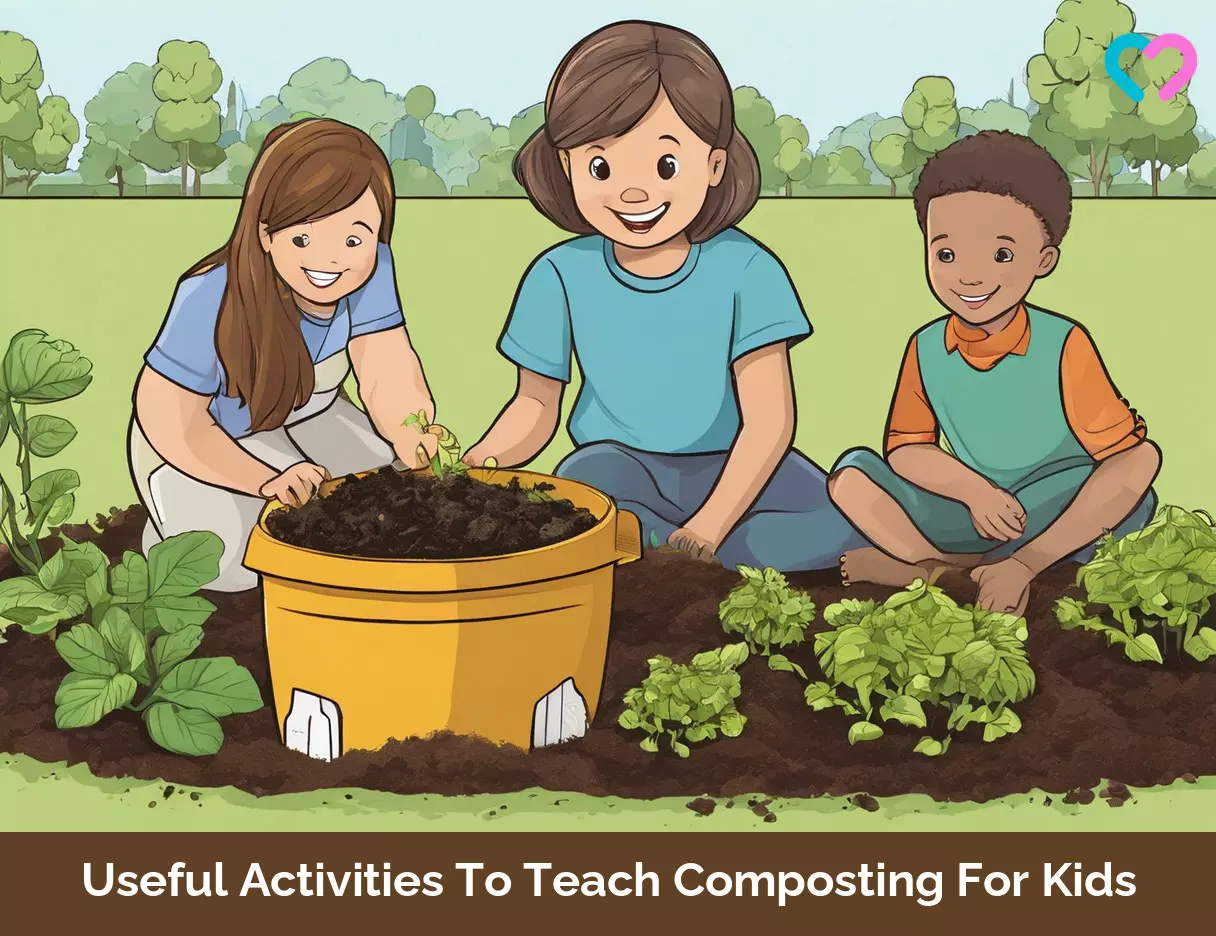
Image: Stable Diffusion/MomJunction Design Team
Personal Experience: Source
MomJunction articles include first-hand experiences to provide you with better insights through real-life narratives. Here are the sources of personal accounts referenced in this article.
i. Teaching small children to compost;https://www.youtube.com/watch?v=dq2qQpZJYeI
References
1. J Fong and P Hewitt; Worm Composting Basics; Cornell Waste Management Institute
2. Composting; Oklahoma State University
3. Water; Cornell Composting
4. Compost Turning: The Key to Quick Composting; Oklahoma State University
5. Common Manure Composting Problems and Their Solutions; North Dakota State University
Community Experiences
Join the conversation and become a part of our nurturing community! Share your stories, experiences, and insights to connect with fellow parents.
Read full bio of Dr. Neha Bhave Salankar
Read full bio of Bharathi V
Read full bio of Harshita Makvana
Read full bio of Kavita Kankani






